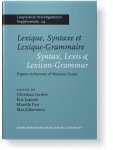La structure de la phrase en français de Belgique
The paper aims at analyzing about 500 verbs that typically belong to Belgian French, according to the principles of the lexicon-grammar set forth by Maurice Gross. Four categories are distinguished, viz. verbs that are totally unknown in France, e.g. loanwords from Dutch (20 %), verbs that sound archaic in France (2 %), verbs that are common in France but with a different meaning, the so-called "faux amis" (8 %) and verbs that are used in France but with a different syntactic construction (70 %). Each Belgian verb is ascribed to a syntactic class, based on the (in)transitive character of the verb, the absence/ presence of a prepositional complement, etc. The Belgian verbs are thus classified in 33 different classes, the largest of which correspond to transitive structures with two arguments, viz. subject and direct object. Two major findings of the paper are that Belgian French differs more from the French spoken in France than is usually assumed, and that the differences not only concern lexical matters, but, maybe more importantly, syntactic differences.
Article language: French
Cited by (1)
Cited by one other publication
Lamiroy, Béatrice & Jean René Klein
2005.
Le problème central du figement est le semi-figement.
Linx :53
► pp. 135 ff.

This list is based on CrossRef data as of 23 october 2024. Please note that it may not be complete. Sources presented here have been supplied by the respective publishers.
Any errors therein should be reported to them.
